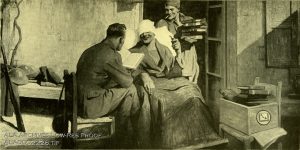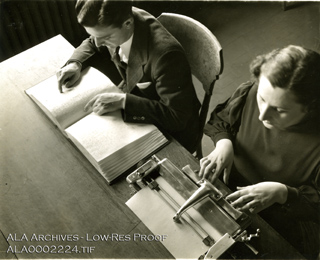
“[T]he blind soldier is the spirit of war, of the battlefront, of France,” said Jerry O’Connor, a blinded Cantigny veteran from World War I, during his award-winning speech titled The Duty of the Blind Soldier to the Blind Civilian at the Red Cross Institute for the Blind’s Public Speaking Contest in 1920. “We have the mud of the trenches upon our feet, gold chevrons upon our sleeves, and the scars of War upon our faces. Whether we deserve it or not, people stare at us, send us gifts, invite us to their homes, give us sympathy. Such circumstances place the blind soldier in a position where, when he speaks, he can be heard. Consequently, if the conditions of the blind can be improved, the blind soldier should speak – and be heard.” Identifying two major obstacles for blind people as “the habit of the public to look upon the blind man as incapable, sensitive, and helpless” and the lack of educational opportunities for the adult blind person, O’Connor called for public programs to address these obstacles for the blind. One of the institutions responding to this call for action would be the American Library Association.
The success of the Library War Service surpassed even the American Library Association’s expectations, and following the Armistice, plans were quickly presented for the Enlarged Program with the slogan, “A Book for Everybody.” As described in a circular letter sent in 1919 from Chalmers Hadley:
“We as librarians could never again be satisfied with pre-war library conditions. We have seen bigger things: we have done bigger things. With our responsibility to the War and Navy Departments discharged, what then lies before us? The answer may be found in the enclosed copy of the preliminary report of the Committee on Enlarged Program for American Library Service […]. The program is broad in its scope. […] It will give an impetus to library development which eventually will provide books for all Americans. It is a venture of libraries into wider fields. We stand to win a high place: to be a force hitherto unknown in popular education, in citizenship, and in the teaching of social responsibility.”[1]
The Library Work for the Blind project was spearheaded by Gertrude T. Rider (Library of Congress) and Caroline Webster (Assistant to the Director of the Library War Service) to continue the ALA’s service for soldiers and sailors by providing vocational and recreational reading for the newly blinded veterans.

Citing seventy-five thousand blind people in the United States and less than two hundred books available in the newly standardized Braille Grade One and a Half, the ALA promised to pay for converting additional titles “into brass” to help meet this need.[2] But the ALA soon realized that their conversion pledge was almost prohibitively expensive. With braille printing cost $6.25 per thousand words, embossing a work like Alexander Dumas’ Man with the Iron Hand would cost roughly $450 ($6,355 would be the equivalent contemporary cost, according to inflation calculators).[3] Additional challenges to converting books into Braille included the dramatically increased bulk of the text. A version of Dickens’ David Copperfield would be twenty-three volumes in Moon-type.
Rider needed as much support as she could gather and wrote hundreds of letters appealing to authors and philanthropists to assist in financing the conversion of books into Braille. She also sought out letters of support by prominent political figures and blind readers, such as Helen Keller.[4] She also oversaw teams of volunteers, mostly women, who saw Braille conversion as a fascinating extension of their work during the War. Rider noted that support for blind readers was not as thorough as other parts of Europe, where in England converting books to Braille was supported by a Mellon grant and “braille transcribing [was] as popular in Sweden as knitting.”[5]
Although the Enlarged Program ultimately couldn’t gather sustained funding and discontinued after 1920, the ALA Archives contains records of the tireless work of Gertrude Rider on behalf of the blind through 1923. The ALA continued to advocate for blind readers in the Committee on Library Service for the Blind, the Round Table on the Library Service to the Blind, and through the work of the Association of Specialized and Cooperative Library Agencies.
Sources:
[1] “To the Librarian” circular letter, Chalmers Hadley, November 21, 1919, Circular Letters, 1917-1920, Volume 2, Record Series 89/1/55, Box 1.
[2] “How ‘Books for Everybody’ of the A.L.A. will help solve Local Library Problems,” not dated, Caroline Webster Papers, 1917-21, Record Series 89/1/21, Box 1, Folder: Committee on Work With the Blind, March – August 1920
[3] Letter from Gertrude Rider to Mrs. John W. Foster, May 10, 1919, Record Series 98/1/8, Box 1, Folder: LWS May-August 1919
[4] Letters found in Caroline Webster Papers, 1917-21, Record Series 89/1/21, Box 1, Folder: Committee on Work With the Blind, Aug. 1919-April 1920
[5] “Notes on Braille,” not dated, Caroline Webster Papers, 1917-21, Record Series 89/1/21, Box 1, Folder: Committee on Work With the Blind, Aug. 1919-April 1920
For more information:
Please view other ALA Archives blog posts about World War I
Caroline Webster Papers, 1917-1921, Record Series 89/1/21
Work With the Blind Program File, 1918-1920, Record Series 89/1/8